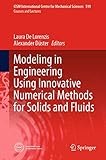Modeling in Engineering Using Innovative Numerical Methods for Solids and Fluids [electronic resource] / edited by Laura De Lorenzis, Alexander Düster.
Contributor(s): De Lorenzis, Laura [editor.] | Düster, Alexander [editor.]
| Düster, Alexander [editor.] | SpringerLink (Online service)
| SpringerLink (Online service) .
.
Material type:  BookSeries: CISM International Centre for Mechanical Sciences, Courses and Lectures: 599Publisher: Cham : Springer International Publishing : Imprint: Springer, 2020Edition: 1st ed. 2020.Description: VIII, 220 p. 120 illus., 97 illus. in color. online resource.Content type: text Media type: computer Carrier type: online resourceISBN: 9783030375188.Subject(s): Mechanics, Applied
BookSeries: CISM International Centre for Mechanical Sciences, Courses and Lectures: 599Publisher: Cham : Springer International Publishing : Imprint: Springer, 2020Edition: 1st ed. 2020.Description: VIII, 220 p. 120 illus., 97 illus. in color. online resource.Content type: text Media type: computer Carrier type: online resourceISBN: 9783030375188.Subject(s): Mechanics, AppliedDiscrete Element Methods: Basics and Applications in Engineering -- Adaptive Integration of Cut Finite Elements and Cells for Nonlinear Structural Analysis -- Numerical Implementation of Phase-Field Models of Brittle Fracture -- Practical Computational Fluid -- Dynamics With the Finite Volume Method -- Tutorial on Hybridizable Discontinuous Galerkin (HDG) Formulation for Incompressible Flow Problems -- Non Intrusive Global/Local Coupling Techniques in Solid Mechanics.
The book examines innovative numerical methods for computational solid and fluid mechanics that can be used to model complex problems in engineering. It also presents innovative and promising simulation methods, including the fundamentals of these methods, as well as advanced topics and complex applications. Further, the book explores how numerical simulations can significantly reduce the number of time-consuming and expensive experiments required, and can support engineering decisions by providing data that would be very difficult, if not impossible, to obtain experimentally. It also includes chapters covering topics such as particle methods addressing particle-based materials and numerical methods that are based on discrete element formulations; fictitious domain methods; phase field models; computational fluid dynamics based on modern finite volume schemes; hybridizable discontinuous Galerkin methods; and non-intrusive coupling methods for structural models.


There are no comments for this item.